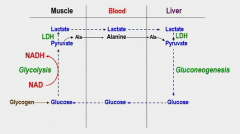![]()
![]()
![]()
Use LEFT and RIGHT arrow keys to navigate between flashcards;
Use UP and DOWN arrow keys to flip the card;
H to show hint;
A reads text to speech;
9 Cards in this Set
- Front
- Back
|
The presence or absence of ___ determines the catabolic fate of NADH and Pyr. Outline the respective fates.
|
O2
in anaerobic conditions: converted to EtOH and CO2 in yeast converted to lactate in muscle, (reversible*) in aerobic conditions: goes to 2 Acetyl-CoA and into TCA cycle to CO2 and H20 |
|
|
Describe the general net glycolysis pathways in aerobic and anaerobic conditions especially in terms of products and energy produced.
____ ____: the rate of glc consumption is __#__ times as great under ___ conditions than ___ conditions |
Aerobic produces 2 pyr + 2ATP + 2NADH
The 2 NADH go through ox-phos to make more ATP Anaerobic Glc --> 2 lactate + 2 ATP (substrate-level phosphorylation) Pasteur Effect: 18x more glc in aerobic conditions (2 vs 36 per glc) |
|
|
Where do proteins feed into this catabolic pathway?
|
Ala <----> pyr
|
|
|
Draw the reaction including structures, enzyme, coenzyme, location, location, and location of pyruvate to lactate
|

|
|
|
When does the body use lactate pathway?
How often do we use this pathway? What hormone comes into play here? |
In situations of high energy demand (body needs a lot of ATP and has a high rate of ox-phos going with a lot of NADH being generated) but O2 can't be delivered fast enough to fulfill these needs especially NAD regeneration for glycolysis (upstream from both ox-phos and lactate)
-By reducing pyr to lactate using NADH, NAD is generated. All the time- no human can send enough O2 to keep up with glycolysis during exercise Epinephrine |
|
|
What's the purpose of cardio workouts as far as improving your fitness-- what are you really doing as far as changing your metabolic pathways?
|
You're improving your oxygen delivery- both O2 per unit breath and its transport
|
|
|
What are the consequences of using lactate pathway?
What other systems do these consequences affect? |
blood [lactate] is high
blood pH goes down (it is lactic acid after all) -> acidosis, fatigue That lower pH (and higher CO2 from metabolism and HCO3 buffering system), though, shifts Hb O2 saturation curve to the right to lower affinity and deliver more. |
|
|
How long does it take the body to clear blood lactate from blood after heavy exercise?
How does it clear it? |
Remove most in about an hour
Converts it to pyr then to glc (in liver) |
|
|
Draw the lactic acid cycle.
What is another name for this? What is a parallel cycle? What are some major big picture differences between the two? |

Cori cycle
Alanine cycle: pyr + Glu <---ALT (ala transaminase)--> Ala + aKG Ala is neutral. No NAD+ regeneration. |

